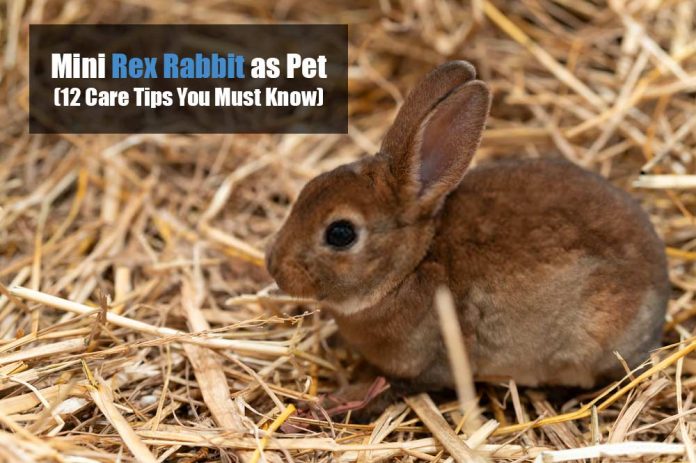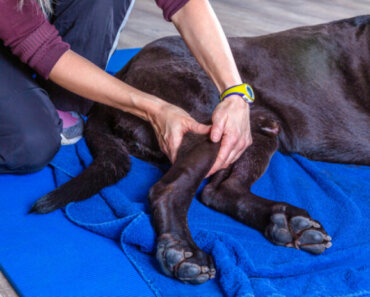Now we’re back into the realm of decidedly good pets. Rex rabbits are adorable, docile, and markedly easier to care for than some of the other animals we write about on this site! The even better news is that mini Rex rabbits are even cuter, lovelier and more adorable than their full-size cousins.
This captivating bunny has an illustrious past, rich with intrigue. The Rex rabbit breed was ‘developed’ by breeders in the sleepy French village of Louché-Pringé in 1919, from a litter of wild gray rabbits.
Following a highly successful showing at an international rabbit show in Paris in 1924, they exploded onto the pet scene. The Rex rabbit’s luscious fur was so enticing that it only took one showing before its popularity soared.
From there, they were introduced to the United States and were accepted into the American Rabbit Breeder’s Association a year later. The humble Rex rabbit has been a staple in the homes of rabbit lovers ever since!
So where does the MINI part come in?
Demand grew for a smaller version of the Rex.
Why?
Because of cuteness.
Rex rabbits typically weigh in at about 9 lbs. The people wanted something more pocket-sized, but equally adorable. The first mini Rex breed was developed in Texas. It was the result of breeding a black dwarf Rex buck with an undersized lynx red doe. Or, if you don’t know much about rabbit breeds, someone put a tiny black male rabbit in with a slightly larger beige female rabbit, and they went at it… like rabbits.
So, we’ve established that mini Rex rabbits are relatively new, very tiny and very cute. But are they easy to care for and handle? How big can they get? What sort of substrate should you lay down in your Rex rabbit’s enclosure? You will find answers to all of these questions, and more, below.
If you still have questions, feel free to ask them in the comments below, or seek help from a local expert. For now, let’s dive in!
Rex rabbit lifespan: how long does a mini Rex rabbit live?
Mini Rex rabbits live 7-10 years in captivity and don’t technically exist in the wild. If your bunny is particularly healthy and doesn’t run into any issues, it might live for 12 or 13 years, but it’s very unlikely to live past 15.
Rex rabbit size: how big does a mini Rex rabbit get?
In terms of feet and inches, they’re roughly half the size of regular Rex rabbits. But they are significantly less bulky. Mini Rex rabbits typically weigh 3.5-4.5 lbs (up to about 2kg).
They are compact animals, and tuck up into small spaces. Their backs are rounded, with well-developed sections: shoulders, mid and hind. Their bodies are fulsome – not particularly lean or squat.
Does (pronounced “doze”, as in, females) are usually bigger than the bucks (males).
Rex Rabbit behavior and temperament
In general, Rex rabbits are affectionate and calm, often behaving maternally towards other rabbits. They are very intelligent animals, and typically enjoy human company, but they can also get on well with other household animals.
However, they are not necessarily child-friendly, despite being considered so in the past. They have very fragile backs, which are easily damaged if they are handled without proper care, or dropped. As a defense mechanism, they are not keen on excess handling, or being picked up incorrectly.
In the wild, rabbits socialize in large groups and occupy land areas covering a lot of space. Of course, you cannot be expected to deliver on both those accounts, but what you can do is pair your rabbit with a suitable companion, preferably of the opposite sex.
Housing: what cages are suitable for Rex rabbits?
To cage or not to cage, that is the question. Wild rabbits live outdoors in fields, bushes, copses and forests, and occupy large areas.
While it can be difficult to emulate these conditions in the home, you can go a long way by simply fencing an area of your garden, and placing a hutch inside. The other option is to keep your rabbit(s) indoors, and train them as household pets. As with cats, both can work, and both come with their pros and cons.
Outdoor housing for mini Rex rabbit
While it may feel like the most natural way to keep a pet bunny, there are actually several reasons why it might be kindest to keep your mini Rex rabbit indoors. Why? For the following reasons:
- Hypothermia is a risk. Outside the confines of a warm home, the wind and rain can penetrate a rabbit’s hutch, causing the rabbit’s health to decline.
- Freezing water – during winter months the water bottle might freeze without anyone noticing, preventing the rabbit from getting enough water.
- Predation – other animals, such as the neighborhood dogs and cats, or even raccoons and other mammals depending on where you live, might attack a rabbit kept outdoors.
- Overheating (heatstroke) – rabbits are very sensitive to heat. They need to be kept at temperatures below 80°F. Most states get summers that get way above 80, so watch out for that!
- Loneliness – rabbits are very sociable animals – they love to feel like members of a family. If you leave your rabbit outdoors, it may have more room to play, but might at the same time start to feel lonely. It is easy to forget about a pet rabbit for many hours (or even days) at a time, if it is kept out of sight. But if it is in the living room, it will get a lot of attention!
- Death by fright – rabbits can actually die of fright at the sight of a predator, or hearing an excessively loud noise.
Rabbits that live in outdoor hutches tend to live just 2-4 years. On the other hand, rabbits that live indoors, as members of a family, live 7-10 years. There are just too many dangers for them out there in the elements. There’s a reason they breed like rabbits, after all!
Indoor housing for mini Rex rabbit
If you’re keeping your rabbit indoors, be sure to rabbit-proof the room. Read more about rabbit-proofing below. For now, here are the basic requirements for your rabbit’s enclosure:
- Size: a cage should be 5 to 6 feet long and about 2 feet wide, and high enough for your rabbit to stand up on its hind legs without its ears touching the top.
- It might be tempting to go for a smaller cage if you have a baby rabbit, but keep in mind that it will grow to full size in just a few months! If you keep two or more rabbits together, increase the size accordingly.
- Floor surface: wire cages can hurt a rabbit’s feet, so go for a cage with a solid metal bottom. If you can’t find one, take a sheet of plywood (or other wood) and cut it to size, so that it covers the cage’s floor.
- Bedding (substrate): cover the floor of the enclosure with 2-3 inches of appropriate substrate. More on this later!
Where to place your pet housing
Place the house in a room in your home that gets used a lot, such as a kitchen or living room. Rabbits need frequent social interaction, and to feel like they are members of a family. To avoid making your pet rabbit feel left out, keep them in a busy room. Couple your rabbit’s cage with at least 32 square feet of safe playing space, fenced off to avoid accidents.
Rex rabbit substrate and bedding
Line the base of your rabbits’ housing with newspaper and then lay 2-3 inches of substrate down. Make sure your rabbit doesn’t ingest any newspaper though, because the ink can be toxic if they eat too much!
This multilayer, thick bedding will help to prevent health problems such as pressure sores. Many rabbits also like to dig and nest, which are facilitated by a thick layer of substrate.
So what is the best substrate? There are many things to consider – comfort, climate, environment, safety…
DO use:
- Hay – safe to eat, comfortable to rest, requires changing daily as it can grow moldy quickly.
- Straw – edible and warm, dust-free and comfortable, and doesn’t require changing quite so often.
- Aspen – safe alternative to pine and cedar (see warnings below) – economical option, and often chosen as the most odor-free. Plus, aspen is very absorbent, and safe to chew on.
- Shredded cardboard – another economical option, as it is readily available at little or no extra cost.
- Paper pulp – absorbent and virtually dust-free, as well as being environmentally friendly.
- Wood pellets – highly absorbent, BUT quite heavy. Wood pellets expand and become dusty if they get wet and then dry out.
- Paper pellets – preferable to wood pellets, these are more environmentally friendly, and lighter.
- Fleece – this may seem like the most comfortable option, but fleece is high maintenance, requiring changing and washing often. Make sure your rabbit is litter box trained before laying fleece down.
Do NOT use:
- Pine or cedar shavings – not for litter either. They may lead to liver and respiratory issues. This is up for debate, but it’s better to be safe than sorry!
- Ponderosa pine needles, because they have been linked to toxicity for domestic species.
Litter box / area
- Here’s what you need to know about rabbits and litter boxes:
- Fill a small litter box with hay, shredded newspaper or wood pellets.
- Place it in a corner of your rabbit’s cage.
- f your rabbit doesn’t start using it immediately, pay attention to where it likes to poop (usually it’s in a particular corner of the cage).
- Simply move the litter tray to that corner, and wait for the change to take effect!
- Place a second litter tray in the rabbit’s play area, and one or two more around your home, so that it always has somewhere to go.
Drinking station
Hydration is key. Always make sure your rabbit has easy access to clean, fresh water.
Drinking dish
Rabbits enjoy drinking out of a ceramic dish, but these are often prone to tipping over. To avoid this, place small sandbags either side to secure it, or simply go for a dish that is sturdy and bottom-heavy enough not to tip over.
Check the dish regularly and refill it whenever necessary!
Water bottle
Arguably a better option is a sipper bottle. The water inside a sipper bottle cannot be soiled with feces or substrate.
Whether you go for a water bottle or a dish, clean it out every day. Be mindful that during summer, you may have to refill your rabbit’s water source multiple times per day to prevent overheating and dehydration.
Accessories and toys
Every mini Rex rabbit has its own unique personality. For this reason, there is no one-toy-fits-all. Instead, try out a few and see which one(s) your rabbit prefers.
As a rule, rabbits like toys they can chew. While you might want to indulge your rabbit by splashing out on something fancy from a pet supply store, a simple toilet paper roll might be the better choice!
Rex rabbit diet: What do Rex rabbits eat?
A mini Rex rabbit’s diet should consist predominantly of high quality hay (around 70%). The remainder should be a healthy mix of fruits, vegetables, pellets and leafy greens. Fruits with high sugar content should only be given occasionally, as treats.
You might want to treat your rabbit to a wide variety of foods, but really the best thing is to stick to what is safe – which equals what they can forage for in the wild. If in doubt, stick to:
- Unlimited grass hay
- 1 cup of green leafy vegetables per pound of body weight per day
- Unlimited water
Before you introduce a new food to your rabbit, do a little research. There are some quite surprising fruits, nuts and veggies that can be fatal to your pet rabbit!
You should NEVER feed your rabbit:
- Avocadoes
- Rhubarb
- Garlic
- Shallots.
Oh, and chocolate! So you can eat all that yourself. If your rabbit eats something toxic, speak to your vet immediately. For a more comprehensive list, follow this link.
Other foods which, despite not being fatal, should be avoided, include:
- Nuts
- Muesli
- Cat and dog food
- Cauliflower
- Raisins
Rex rabbit grooming and cleaning
Like cats, rabbits are fastidious self-cleaners. Do not wash your pet rabbit with water, unless it has ‘poopy butt’. Here’s a video that shows you how to clean a rabbit’s hindquarters and genitals.
Giving a bunny a full body water bath can be extremely traumatic, and rabbits can quite easily die from shock. Most rabbits will not tolerate being submerged.
Brushing
To remove excess dirt from your rabbit’s luscious coat, use a specially made rabbit-fur brush. When you are finished, wash and dry the brush so that it is clean and ready for next time. Handle the rabbit very gently, and stop if your rabbit seems upset.
Spot-cleaning with cornstarch
Spot-clean your rabbit only if absolutely necessary. Do this by sprinkling cornstarch over the dirty spot and using a fur comb to work out the dirt.
Spaying/neutering your Rex rabbit
If you do not intend to breed your mini Rex rabbit, get it spayed or neutered as soon as it reaches sexual maturity. This should occur at around 3-4 months old in males, or 4-6 months in females.
Spaying and neutering not only prevent unwanted litters, but also protect your pet’s health in the following ways:
- It will reduce or eliminate hormonal behaviors such as urine spraying, food guarding, aggression and fighting.
- Fertile females have a higher risk of developing uterine cancer.
Keeping your Rex rabbit healthy
Dental health
Rabbit teeth never stop growing. In the wild, rabbits look after their teeth by chewing pieces of hay and bark. If you notice that your pet rabbit is chewing compulsively, bleeding from its gums, or suffering any other sort of dental ailment, contact your vet immediately
The teeth may be growing into the jaw, which will lead to loss of appetite, drooling and sluggish activity.
Ear health
Rabbits’ ears are large, distinctive and, in many ways, quite delicate. While rabbits can look after their own ears, they might get mites, which they can’t get rid of themselves. Check your rabbit’s ears for mites regularly.
Conclusion
The adorable miniature Rex rabbit is one of the United States’ favorite rabbit breeds. These delightfully diminutive bundles of fluff capture our hearts for their luscious coats, floppy ears and docile temperaments.
Maintenance – not a great deal of effort is needed to successfully house a mini Rex rabbit. They are small and quite easy to look after.
Handling – they may not be the easiest to handle, but as long as you are careful you should be able to interact regularly with your mini Rex rabbit.
Cost – mini Rexes are available at most pet stores, and from many sellers online, for as little as $25. You don’t need any permits to adopt one, and if you look after it well, you shouldn’t need to spend much on vet bills.
Overall, the mini Rex rabbit makes an excellent pet for a beginner. As long as you handle them carefully, there isn’t much risk to anybody. Enjoy!
As always, like, comment and share this guide with anyone who might be interested. If you have any rabbit-related stories, write them in the comments below!



























